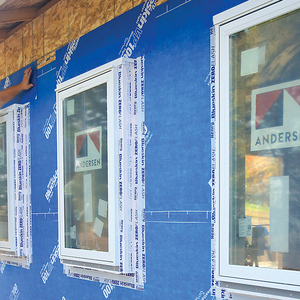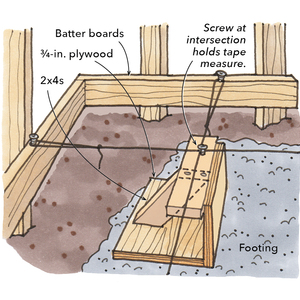Air leakage in balloon frame house
Hi all,
1929 2 story balloon frame house. Last summer, I had a fan blowing out an upstairs window for cooling. I was working on the ceiling fixture in the first floor bedroom. There was a soft breeze coming from the ceiling junction box, and I could smell the attic. Above the first floor bedroom is the second floor bathroom. Looking in the plumbing access door behind the tub, I see that where the tub meets the exterior wall, there is no wallboard – one can see the open stud cavities of the exterior wall. At the bottom of the cavities sits some loose rock-wool insulation – the same sort as in the attic. This would suggest no fire blocking at the second floor ceiling level. The vent stack plumbing route probably plays a role in providing an open airway to the attic, possibly all the way from the first floor bathroom. The kitchen drain and vent stack are on the opposite side of the house and runs from the basement to the attic, with only a wad of fiberglass batt shoved in as an air block. I have since installed proper blocking.
It’s time for a roof, so should I tear up some sheathing boards to add fire blocks at these points?
Better ideas? In the meantime?
Brrrr.
Scott



















Replies
I finally figured out the route air is taking into our attic:
Through the carpet covering the rough-framed half-flight leading out of the lower level, into the enclosed space below the stair.
Into the adjacent "wet wall", through the gap in the drywall, since the sheet didn't quite reach the floor.
Up the wall behind the shower and into the drop ceiling above the shower.
Through the cutout for the tub drain of the upstairs bathroom and into the space under the tub.
Back into the wet wall of the upper floor.
Out through the opening in the stud wall left by the drop ceiling above the tub.
do you have...
...a ballon framed house dan?
(If I can get the pictures to work) Here is the open area under the stairs. The house is a split entry and this is the half-flight down from the entryway (which is carved out of the attached garage). So the wall to the right is the "outside". Just beyond the back wall is the downstairs bath, and the upstairs bath is directly above that.
The dropped ceiling in the downstairs bath covers the entire bath (which is small, but includes all of the visible wall and some more). So the opening below the drywal "communicates" directly with the dropped ceiling.
The house is normal platform framing, meaning that the stud cavities do not "communicate" with the second floor stud cavities. However, there are several penetrtations through the second floor sheathing, most notably the cutout for the tub drain (directly above the area in the photos). From that cutout air can pass under the tub and into the studwalls all around.
Above the tub on the top floor is another drop ceiling covering just the tub (roughly over the two right-most stud bays in the photos). So air can flow under the tub and into the upstairs studwalls, from there into the dropped ceiling and into the attic.
I've covered the opening in the photo with plastic (and foamed some cracks), so the downstairs is fairly well covered. Next step is to open the access panel behind the upstairs tub and somehow seal the opening around the drain. (And also make sure the access panel itself is well sealed.)
The last shot shows the access hole I used, about 19x20. 30 years ago I might have gotten away without having to cut out a stud, but it was clear that wasn't going to work. As it was I stripped down to my skivvies to do the work, and barely had room to sit upright. The work wasn't pretty, but I think I got it all sealed.
It was 11 below this AM, so stuck my head up the hatch to check: In the area where there had been heavy frost earlier, no frost at all!
So this kind of illustrates how air can migrate upward and into the attic through unlikely channels.
adding fire blocking...
...is not going to be easy but if it can be done it should be.
you could accomplish a lot of air sealing by using some expanding spray foam insulation and blown in cellulose in your sidewalls.
this can be done a whole lot less intrusively than adding fire blocking.
are you capable of such a project or would you need to hire it done?
I've been doing incidental insulation of the exterior walls - as I do other projects that will require paint, I bore holes through the plaster and fill the cavities with loose-fill fiberglass, to the manufacturer's density spec. So far only the kitchen, first bath and parts here & there. Probably no more than one fifth of the first floor, total. Not having thought of it, I did not seal the fire blocks at the second floor's floor level.
Fire-blocking the cavities at the second floor ceiling/attic level may not be a DIY since there is very limited access in the crawl space - see photo. That's why I asked if it should be done during a re-roof as access by removing some roof sheathing may be the only way to get there. I might have the roofers block it, or tell them to come back tomorrow, so I can do it.
Since the open stud cavities are accessible in the basement, I suspect that air leaks past some or all of the fire blocks from the basement to the attic, or visa versa since the air is colder in the walls than the basement. Should I caulk or foam around those fire blocks to stop any air that might leak past? During a nice cold winter like this one, the basement is about 48F. I had thought of cutting 1/4" pieces of pine to loosely match the fire blocks, spray some Great Stuff on the face and sandwich it to the face of the existing fireblock as a means of pushing the foam out to the edges to seal it. Otherwise, trying to get the foam dispenser hose up there, past the rim joist, seems and endless headache.
good!
Then you dont need fire blocking!
Unfortunately back in the 70s the focus was not on energy savings like we have or at least are supposed to have in today's buildings.
Ever done a blower door test on your house dan?
Trust me, a blower test would be pointless. Good ol' M. R. (Mac) McDonald was not known for the quality of his construction.
And I kinda wonder about that fireblocking. When I was redoing the upstairs shower head I got a small fire started in the stud cavity. It was a clear shot to the attic. (Thankfully I'd pulled out the newspaper I'd stuffed into there to keep the wind from howling so bad.)
I agree completely dan...
...that a blower door tyest would be pointless. You need a pre and post test anyways to really get a proper read with a blower door.
We used them more or less for a dog and pony show for people who were unfamiliar with reduction of air infiltration/exfiltration .
After awhile you get to know juat how to effectively tighten up a house and you just do it. Those of us who do the work "dont need a weatherman (blower door test) to know which way the wind blows"-to quote a fellow Minnesotan (Bob Dylan)!!
About your close call with soldering pipes-be careful!
I have used the heat protective pads for many years now and leave way less charred framing and I feel a bit safer with them in place when soldering fittings on copper and brass.
Air leakage in balloon frame house
Any suggestions for removing a 4" tall segment of plaster over blue-board at the top of the wall? That should be enough access to screw fire-blocking between the studs at ceiling level, then caulk it to stop airflow between the attic and wall cavities. In past similar tasks, I've used a carbide jigsaw blade, but it's slow and messy. A can light hole saw with a bucket to catch the dust works great, but does not give good enough access to drive screws. In the past, I've kept the pieces I've cut out and glued them back in place with Durabond, so bashing out the plaster with a hammer leaves something to be desired.
Around the bathtub, which is on an exterior wall, I also need access between the tub and wall since that part of the stud cavity is open and could use some fiberglass batting and drywall. There is no good access from the plumber's hatch, for anything bigger than a cat.